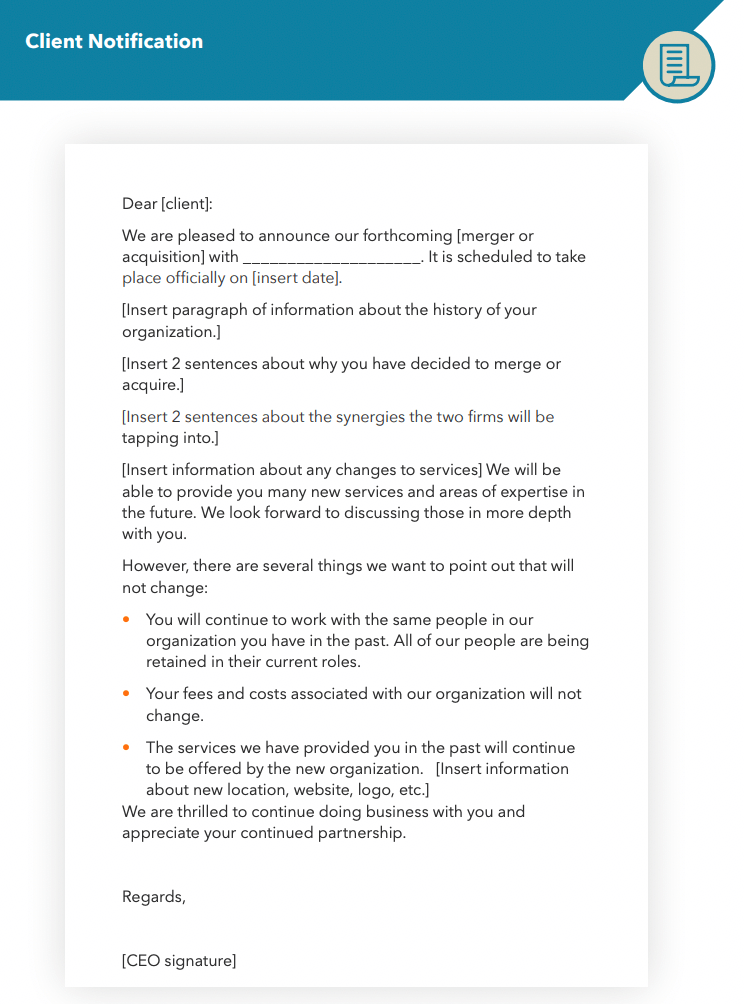
Mergers and acquisitions are an exciting time for any organization. But they can also be stressful when you have to figure out how to write a letter to announce said merger or acquisition to your clients.
Communicating large changes effectively, such as a merger or an acquisition, is important to maintain good relationships with your clients.
You might be thinking, why should I focus on my clients during such a hectic time?
Think about it this way: your clients are the blood and the pulse of your organization. Without the revenue generated from their business, your entire organization could falter.


And yes, new business is important, but sustaining your current business is even more important to maintain growth and brand name across the industry.
It is easy for leaders to fall into the trap of focusing on all of the new clients and businesses that they will obtain from the merger or acquisition, which can then lead to the attrition of clients if they aren’t catered to properly during the transaction.
In some industries, losing just one client can have a huge impact on your yearly financial statements. A small startup that sells software for a subscription fee of one million per year to five different companies could lose 20% of their revenue if they lose just one client. Ouch!
So now that we know why it is important for you to communicate these changes to your client, you need to understand why your clients find these specific changes important to them.
There are several reasons why a client could potentially care about your merger or acquisition.
Have you ever had a super-engaged client? Well, those are called your brand evangelists. They love your company, give you referrals, subscribe to all your communications, and are super users.
For example, I love the brand Halo Top. (They sell low-calorie ice creams that taste pretty good!) I follow all of their social pages, and whenever they release a new flavor, I want to know about it so I can go buy it and test it out. I also tell all of my friends and family about the product as well. I am an evangelist.
Well, your evangelist clients will want to know about your merger and acquisition because it will be newsworthy to them. Just like how Halo Top ice cream releases are newsworthy to me!
Besides this reason, you also have an obligation to your clients to alert them to any changes in your service. You might not think that the merger or acquisition will change your service, but it might impact how your client sees your service.
For example, let’s say that you acquire a small business that has ties to a manufacturing firm. This manufacturing firm is a competitor of one of your clients. This could potentially change how your client views your service.

They could see this new business relationship as a conflict of interest for their organization and need to re-evaluate using your services.
Another example of this would be if you merged with an organization that had technological advances far beyond your current offering. Alerting your clients to this could help them save money on their vendor expenses if they were trying to purchase something with the same functionality, and also strengthen their relationship with your brand in return.
Finally, when an organization is acquired or two organizations merge, there are usually changes in processes and technological systems. Your clients need to be alerted of this far in advance so that they can minimize the impacts on their internal systems. Not alerting them of this, and then having a huge break or change in your service could jeopardize their productivity, morale, and even their revenue. Which would be very bad for your business relationship!
Now that you understand why communicating your merger or acquisition to your clients is so important, let’s break down how you should notify them.
For some of your clients, it might make more sense to give them the news in person. For example, if you work with one high-impact client that you need to keep happy to have more stable revenues, you should probably take the time to notify them in person.
But generally sending over a letter (via email) to notify your client of a merger or acquisition is perfectly acceptable.
It is recommended that you carefully choose the timeframe when the email will be sent as well. It is important to tell your clients far enough in advance so that they can prepare for how it will potentially impact their business, and you also want to make sure they get the news before it breaks in the press.
So once you have figured out the time frame and the channel of delivery it is time to craft the letter. Here are the sections your letter should include:
The sections listed above are the basic things you should include in your letter to your clients.
While every merger or acquisition client letter should contain this type of information, it is important to think about the following considerations:
If done correctly, your client notification should accurately update your clients on all of the news surrounding your merger or acquisition. By doing so, you ensure that your clients are in the know, ready to potentially make changes, and have an understanding of what is happening with the partnership you have created with them.
As a note, it’s important to mention that these letters should be customized to fit your business. The samples presented here are to get you started on that journey by showcasing a typical, standardized letter.


Aley is a versatile global business leader with proven experience managing high-performing teams and engaging a data-driven approach to strategies that exceed company objectives.
Download our outplacement comparison sheet
Compare our rates to other providers

Listen to stories of career transition and fulfillment